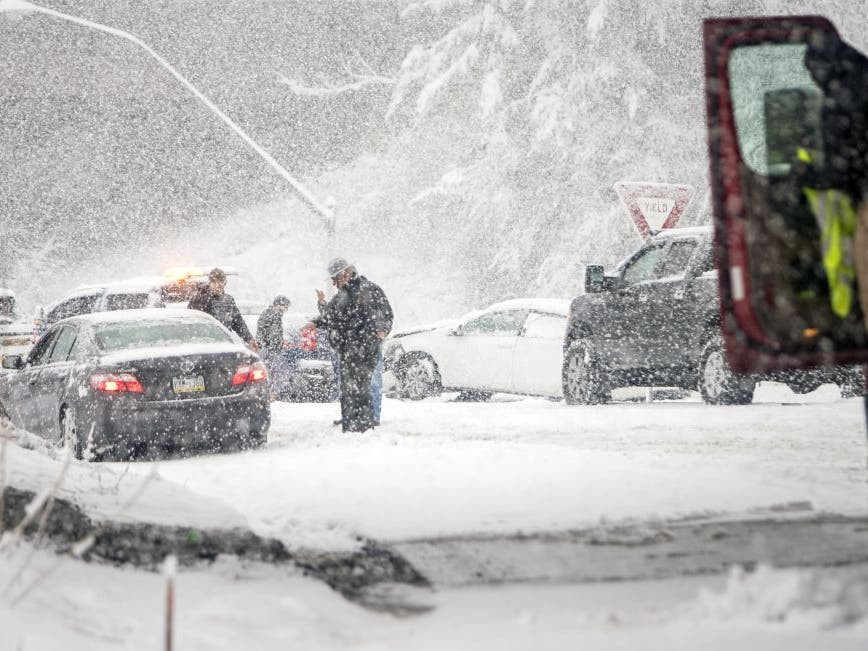Understanding the Danger of Snow Squalls
It’s that time of year again when we must watch out for snow squalls, one of the most dangerous and underplayed winter hazards. A snow squall is a brief but intense period of heavy snowfall and strong winds that can quickly lead to whiteout conditions, zero visibility, and dangerous driving situations. These events are most common in the northern U.S., particularly around the Great Lakes, from November to March. The key difference between a snow squall and a snowstorm is duration; squalls are short-lived (30-60 minutes) and intensely localized, while snowstorms last much longer and affect wider areas. The National Weather Service (NWS) issues snow squall warnings to alert the public and local authorities, triggering Wireless Emergency Alerts on smartphones.
The Dangers of Driving During a Snow Squall
The consequences of encountering a snow squall while driving can be severe. According to the Department of Transportation, over 1,300 people are killed, and more than 116,800 injured annually in vehicle crashes on snowy, slushy, or icy roads. A snow squall dramatically reduces visibility to near zero, making it difficult to see other vehicles or hazards. The sudden onset of intense snowfall and strong winds can also cause flash freezes, creating extremely slippery driving conditions. These factors can lead to high-speed accidents and large pileups, resulting in injuries and fatalities.
Staying Safe During a Snow Squall
When snow squalls are in the forecast, the safest course of action is to avoid or delay travel altogether. Stay informed by monitoring weather.gov or your local NWS Forecast Office. If you must travel, be prepared to react quickly if a snow squall warning is issued. Ensure Wireless Emergency Alerts are enabled on your phone. Upon receiving an alert, safely exit the road immediately and wait at least 30-60 minutes, or until the warning expires.
Defensive Driving During a Snow Squall
Imagine you’re driving and a squall hits unexpectedly with no immediate escape route. Visibility rapidly declines. What do you do? Practice defensive driving techniques. Turn on your headlights and hazard lights, and increase the distance between you and the vehicle in front. If you lose control, pump your brakes and steer carefully to regain control. Avoid sudden braking or sharp turns. If traffic slows or an accident occurs, proceed cautiously and only if safe to do so. If you must stop, remain in your vehicle with your seatbelt fastened, away from the road if possible. Remember, there's no safe place on the road during a snow squall.
Preparing for the Next Snow Squall
Remember the 2024 winter storms that hit Southeast Michigan? They brought low visibility and dangerous road conditions, reminding us that even in areas accustomed to winter, snow squalls can still catch drivers off guard. The Michigan State Police reported over 200 crashes over the Thanksgiving holiday, suggesting that drivers may be rusty in handling winter conditions. First Lt. Michael Shaw advises driving cautiously, maintaining a safe following distance, and avoiding abrupt maneuvers. He said that drivers should avoid sudden braking, as this only leads to further loss of control.
The forecast for the coming days includes the possibility of more snow squalls, prompting some drivers to prepare accordingly. These drivers already have essentials like ice scrapers and extra clothing prepared in their vehicles; however, this does not eliminate the importance of having a winter emergency kit in your vehicle in case you become stranded for an extended period of time.
Several individuals interviewed share their sentiments regarding these snow squalls; one interviewee remarked, “It does not help that we don’t get our winters like how we used to. So, when it does happen everyone is like, ‘Oh, no,’” reflecting a common feeling among drivers. Another added that “[Don’t] drive like an idiot. Be vigilant you kind of have to drive for other people as well,” highlighting the importance of courteous and responsible driving during these conditions. Local news channels continue to advise drivers to stay informed about weather alerts and adapt their driving accordingly, utilizing strategies like the READ rule which incorporates maintaining the right speed, maintaining visual awareness (eyes up), brain on, and keeping a safe distance from other vehicles. Staying updated on weather forecasts is crucial to avoid dangerous situations.
Navigating the Blizzard: Your Winter Survival Guide
A Winter Weather Advisory is currently in effect for several counties, with 1-3 inches of snow and very strong winds expected. Road conditions will likely be slick, and wind chills will be dangerously low. The advisory extends through 4 a.m. Thursday. Thursday will remain windy, with wind chills near zero. Expect mostly cloudy skies and a chance of snow showers. Highs will be in the upper 20s, but wind chills will stay in the teens. Friday will be mostly cloudy, breezy, and chilly, with highs around 30°.

















